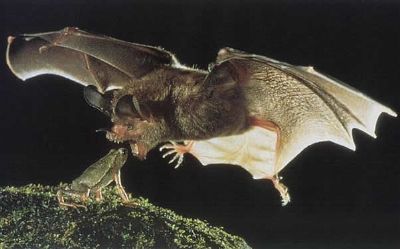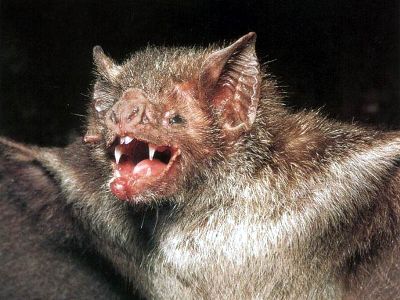In Romanian folklore it was thought that a bat, insect or other flying creature that passed over a corpse, could turn it into a revenant (a corpse that returns from the grave). In fact, bats are much like vampires. They are nocturnal, some species drink blood, and they have an acute sense of hearing and smell. The discovery of blood drinking bats only exacerbated the vampire myth.
Bats are very often associated with vampire lore, though out of about 1,000 species of bats, however only three suck blood. The bats of the United States are harmless and, in many cases, useful. The useful ones live on insects; others by sucking the juice from fruit on trees.

Three different species of Vampire Bat are exclusively hematophagous, meaning they feed only on blood: Common Vampire Bats (Desmodus rotundus), Hairy-legged Vampire Bats (Diphylla ecaudata) and White-winged Vampire Bats (Diaemus youngi). Two of those — the hairy-legged vampire bat and the white-winged vampire bat — mainly prey on birds, while the common vampire bat (pictured) is a bit more versatile.
Vampire bats are members of the New World Leaf-nosed bats, the Phyllostomidae. Biologists have argued for years about whether vampire bats should be housed in their own family (the Desmodontidae) or included among the New World Leaf-nosed Bats (the Phyllostomidae).
All three species of living vampire bats occur in South and Central America. The three species are medium-seized, with adult wingspans of 320 to 350 mm and weights of about 40 grams. While they are larger than most of the bats of the temperate zones of the world, vampire bats are much smaller than Gigantic Flying Foxes, which weigh in at 1,500 g.
Evidence from proteins suggests that vampire bats have been around for 6 to 8 million years. Fossils of three other species reveal that several thousand years ago vampire bats were more widespread. They are known from Cuba and from as far north as West Virginia and the northern California, places where they no longer occur. With the exception of captive animals, vampire bats have never been found outside of the New World.
Common Vampire Bats or “Desmodus rotundus” are the most widespread of vampires. They adapt well to captivity and often are exhibited in zoos. Hairy-legged Vampire Bats and White-winged Vampire Bats are less common and are less often caught by biologists.

Primarily found in areas of Central and South America and a few areas of the southern United States, the vampire bat is small in size but bears a particularly frightening appearance that lends to its feeding habits, including an erect stance, large eyes, teeth that are incredibly sharp, and a lower lip possessing a cleft.
Today it feeds mainly on cattle, horses and other livestock, as well as humans, a diet that likely helped it avoid extinction. Its bite alone isn’t dangerous, but it can spread rabies, which poses a public-health threat across much of its habitat. This year, for example, four children died in Peru after vampire bats sparked a rabies outbreak among the local Awajun tribe.
Common Vampire Bats live together in structured societies or colonies that usually include one adult male with several females and their young. Like other bats, Common Vampires survive almost 20 years in the wild.
